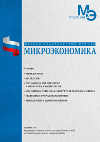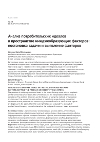Analysis of consumer ideals in the space of image-forming factors: setting the problem and identifying factors
DOI: 10.33917/mic-2.97.2021.19-31
The problem of analyzing consumer ideals in the image-forming space with an emphasis on the correctness of the application of methods and the interpretation of the results is considered. The problem definition and the features of using the methods of its solution are discussed. The approaches and methods of identifying image-forming factors that determine market processes and constructing a market structure in which market objects are displayed in the optimal form for solving the task are analyzed. The concept of product/ brand/ company promotion based on the analysis of consumer ideals is presented.
References:
1.IBM SPSS Statistics. Help system. IBM, Inc. 2012 … [Electronic resource]. – Access mode:
https://www.ibm.com/support/knowledgecenter/ru/SSLVMB_26.0.0/statistics_mainhelp_ddita/spss/categories/categories_introduction.html (date accessed: 12.12.2020).
2. S.A. Aivazyan, I.S. Yenyukov, L.D. Meshalkin. Applied statistics: Bases of modelling and initial data processing. Moscow: Finance and Statistics, 1989. 607 p.
3. S.A. Aivazyan, V.M. Buchstaber, I.S. Yenyukov, L.D. Meshalkin. Applied statistics: Classification and reduction of dimensionality. Moscow: Finance and Statistics, 1983. 471 p.
4. I.A. Grigoryants, E.Y. Bobkova. Modern trends in consumer behavior on the consumer goods market of Samara city // Scientific journal of the National Research University ITMO. Series: Economics and Environmental Management. 2014. No. 3. pp. 116-129.
5. M.L. Davison. Multidimensional scaling. Moscow: Finance and Statistics, 1988. 254 p.
6. S.V. Zakuskin. The commercial attractiveness for the segmentation of the target group // Creative economy. 2021. Volume 15. No. 2.
7. S.V. Zakuskin. Segmentation of the target group based on consumer preferences // Creative economy. 2021. Volume 15. No. 1.
8. S.V. Zakuskin. Evaluation of the relative and absolute attractiveness of target group segments // Marketing and marketing research. 2020. No. 2. pp. 92-102.
9. S.V. Zakuskin. The market of services of entertainment centers: a look through the prism of image-forming factors. Part 1. The emotional aspect of a general solution // Creative economy. 2019. Volume 13. No. 5. pp. 1003-1026.
10. S.V. Zakuskin. Identification of the target group using market factors // Russian entrepreneurship. 2018. Volume 19. No. 9. pp. 2691-2712.
11. S.V. Zakuskin. Integration of marketing communications based on the analysis of consumer preferences // Russian entrepreneurship. 2018. Volume 19. No. 6. pp. 1913-1937.
12. P. Nikiforova, O.P. Nikoforova, I.V. Antokhonova. Assessment of Trends in Fish Products Consumption by the Citizens of the Buryatia Republic // The economy of the region. 2017. Vol. 13, No. 3. pp. 948-958.
13. O.K. Oyner, E.K. Panteleeva. Customer centricity approach to managing FMCG-companies in the Russian market // Manager. 2019. Vol. 10. No. 2. pp. 11-20.
14. A.I. Orlov. Non-numeric statistics. Moscow: MZ-Press, 2004. 513 p.
15. I.M. Romanova, A.N. Trotsenko. Segmentation of the passenger car market in Vladivostok city based on the analysis of consumer preferences // Practical marketing. 2012. No. 5. pp. 31-39.
16. O.V. Sogacheva, E.S. Simonenko. Use of the marketing communications and PR -management in the modern socio-economic conditions as the tool for evaluation of the company competitiveness: Practical Aspects // Business. Education. Right. 2014. No. 2 (27). pp. 164-170.
17. A.Yu. Terekhina. Data analysis by multidimensional scaling methods. Moscow: Nauka, 1986. 168 p.
18. K.G. Frolov. Consumer preferences as the factor of competitiveness of trade enterprise in modern conditions of managing // Microeconomics. 2013. No. 5. pp. 55-57.
19. W. Chan Kim, R. Mauborgne. Blue Ocean Strategy. How to Create Uncontested Market Space and Make the Competition Irrelevant. Moscow: Mann, Ivanov and Ferber. 2017. 336 p.



